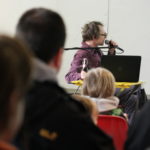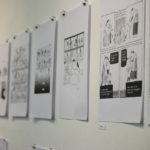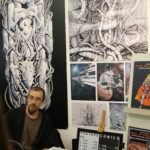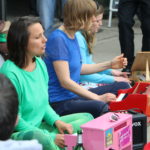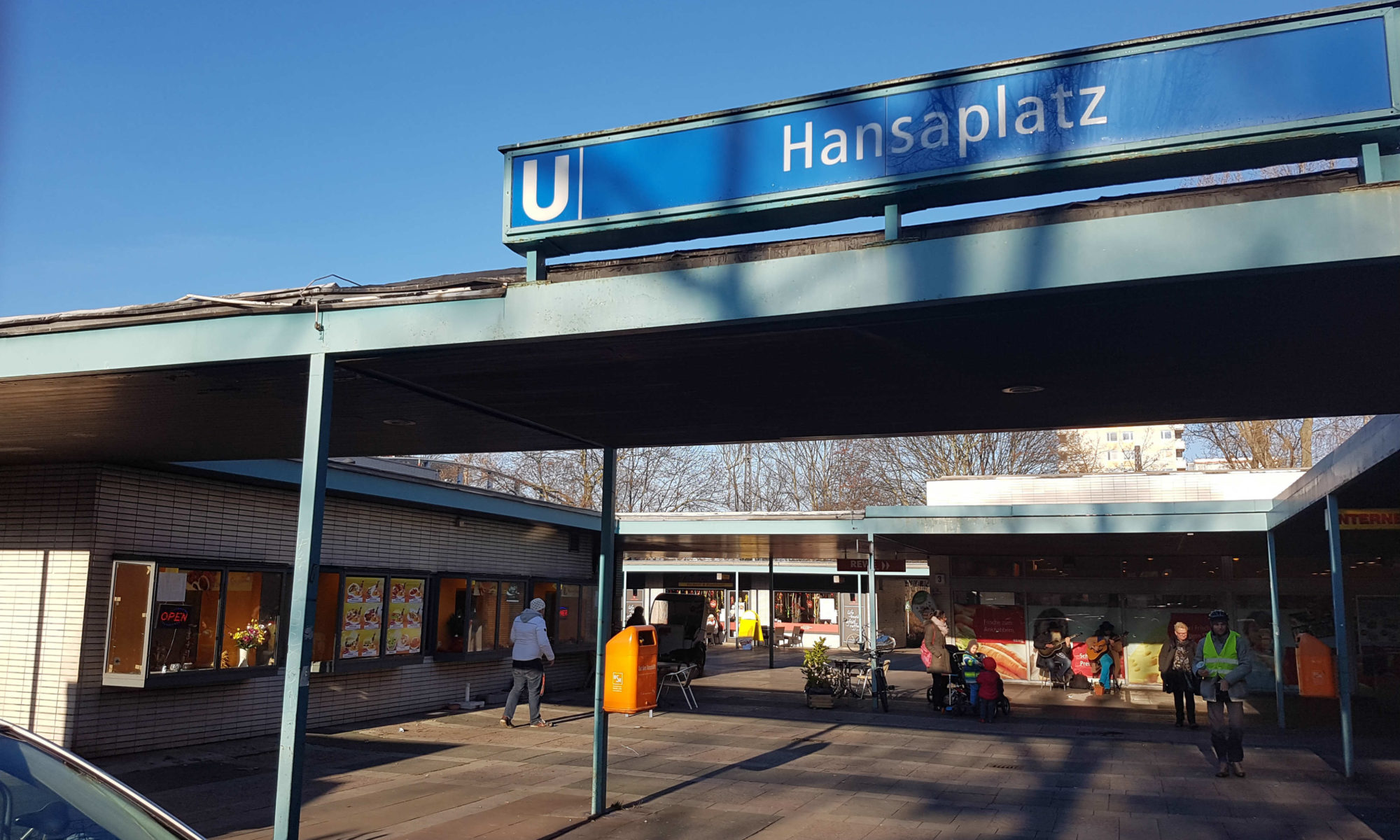Our text adventure about AI interaction can be found here. Have fun!
Sinister Twitter Bots
Bots are everywhere on the web, working behind the scenes to automate tasks so that they are completed quickly and efficiently, and are relatively easy to create. It is estimated that bots drive 62% of web traffic, working in areas like search engines to execute functions much faster than any human could. Because of how easy they are to create, they can be easily mistaken for real people on platforms with simple formats such as Twitter. This can be fun, like a Twitter bot that tweets out a new recipe everyday, or something more sinister. For this project we’ll focus on the more sinister uses of bots on Twitter, specifically on the use of political bots and how they can influence political elections. A recent study estimates that between 9 and 15 percent of all active users on Twitter are bots, and during the election they are thought to have been responsible for around 3.8 million tweets over a month, or about 1/5 of the entire political conversation during that time. This is a particularly salient topic after the U.S. election, where bots are thought to have influenced the outcome, and before the German election, which is coming up in September. From recent studies, it seems as if political bots are not as big of a problem in Germany as they are in the U.S., but their influence will likely only increase.
A study looking at the percentage of tweets coming from bots, or high frequency accounts, during the presidential elections in Germany:
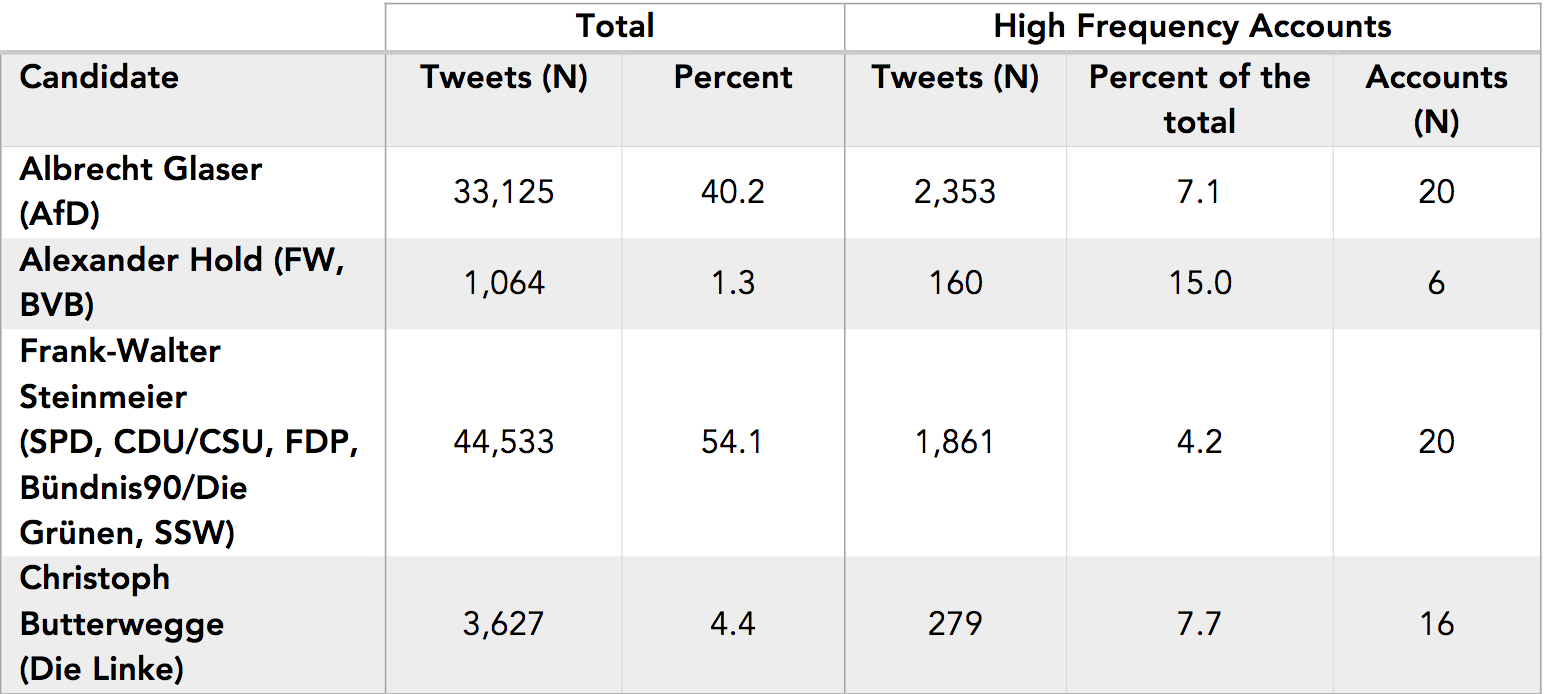

There are many different kinds of political bots, and whether you think a certain one is ‘good’ or ‘bad’ will probably depend on your political views. For example, the bot @ilduce2016 had only one purpose, which was to tweet quotes from Benito Mussolini to Donald Trump with the hashtag #makeamericagreatagain. It did this tirelessly for months, until one day it was successful and Trump retweeted a Mussolini quote, causing a small scandal (although in the context of Trump it was a very small scandal). The political bots that people are more worried about, however, are those who real people think are human and engage in conversation with. Although it becomes obvious after a while that you’re not speaking to a person, political bots can have serious influence on how people perceive political candidates over Twitter. They become a part of the conversation and the fact that they’re not real people can get easily lost in the stream of activity. They are also usually more actively supporting conservative political candidates, so in a country like Germany where there is fear of a right-wing surge such as the one that just happened in the United States, recognizing online bots is a big topic.
Dawn Hightree, a user tweeting to Merkel seems like she could be a bot…
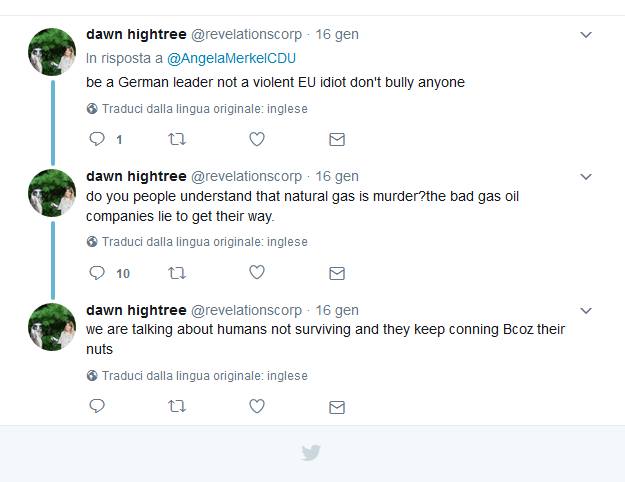
They can be, however, hard to recognize when just looking at one or two of their tweets. More of their tweets taken together or a look at their profile can usually alert someone that there are issues with the user, but even then it is not so obvious. They don’t look too different from real people users, and sometimes users that are real people look like chatbots!
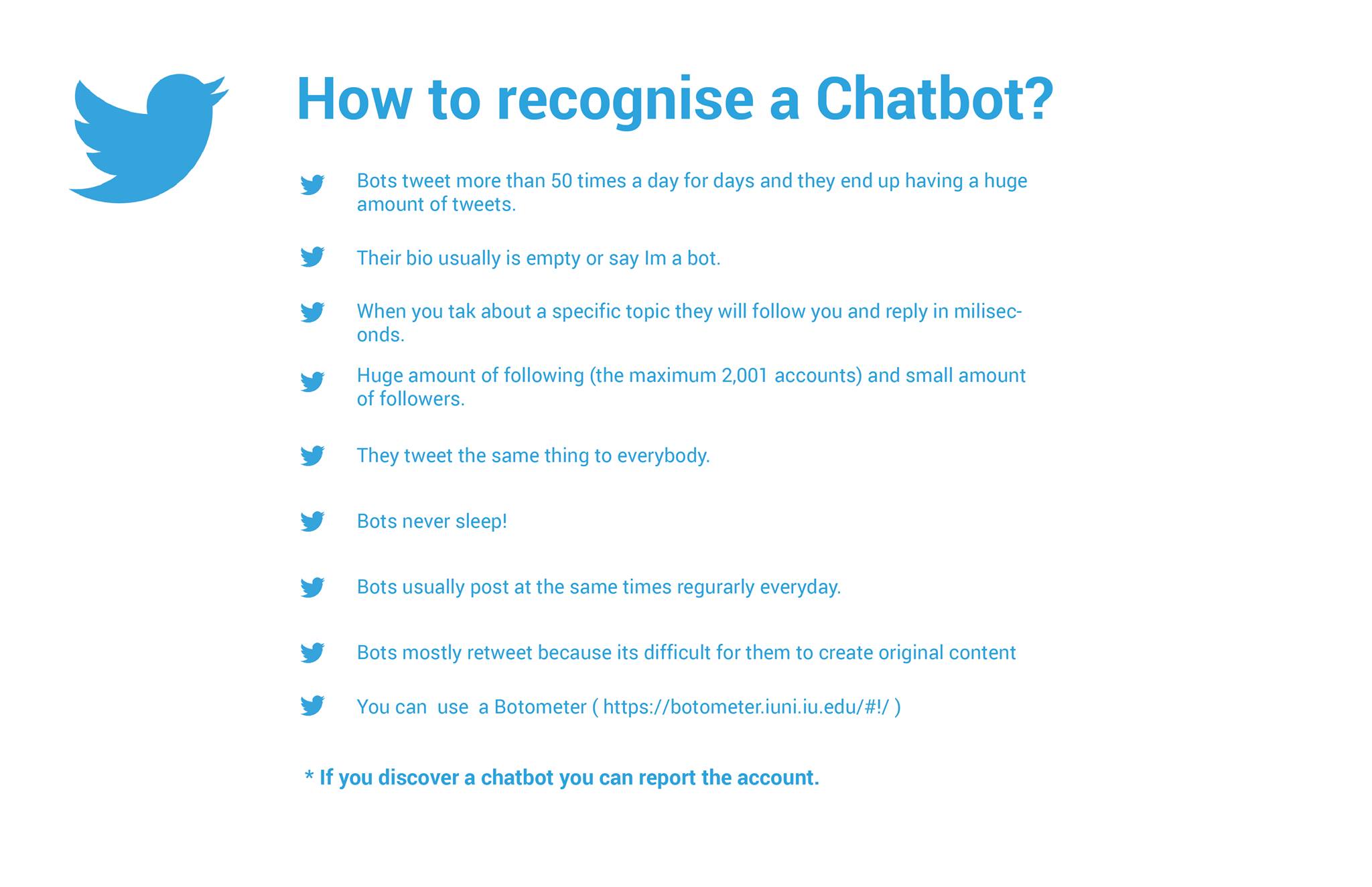
Coming back to Dawn, a look at her profile tells us that she *might* be a bot. She has a high following to follower ratio, no bio, and tweets quite often about the same kinds of topics. However, her tweets are not all the similar and she has some pictures of herself, so it is hard to tell.
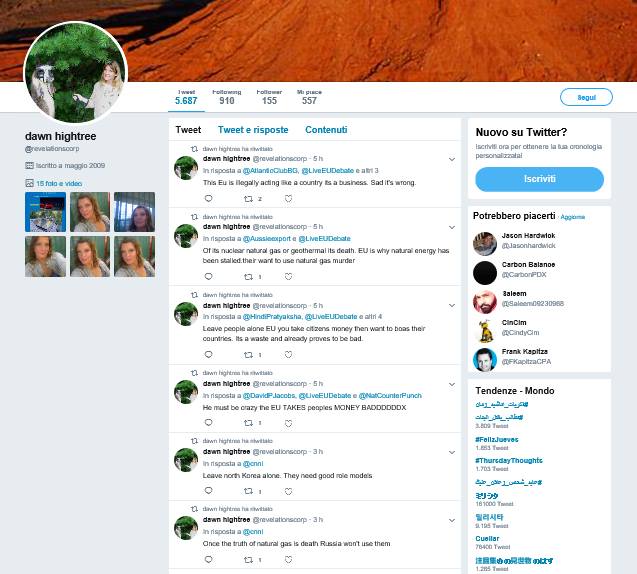
Our bot or not tool says…

Probably not a bot. Let’s check out the Mussolini bot we talked about earlier:

Seems like a bot! And with the tool?

This also shows the limitations of our tool though, as it only ranks at 47% overall, even though the content comes in as 88% bot.
Additionally, artificial intelligence is being used to make bots seem more like real people, which can have some interesting/ fun uses. In the context of political bots on Twitter, however, this is going to make bots much harder to spot, which is going to have much more serious influence on elections in the future. Imagine you’re having an engaging conversation on Twitter about a political candidate and they provide some convincing arguments as to why the candidate is better or worse than you previously thought. Unbeknownst to you though, the person you’re speaking to is a bot employing AI, continuously searching the web for arguments that are going to be perfect to change your mind. Here’s an example of a bot that you might not recognize just from the tweets (if it didn’t say bot in the title):
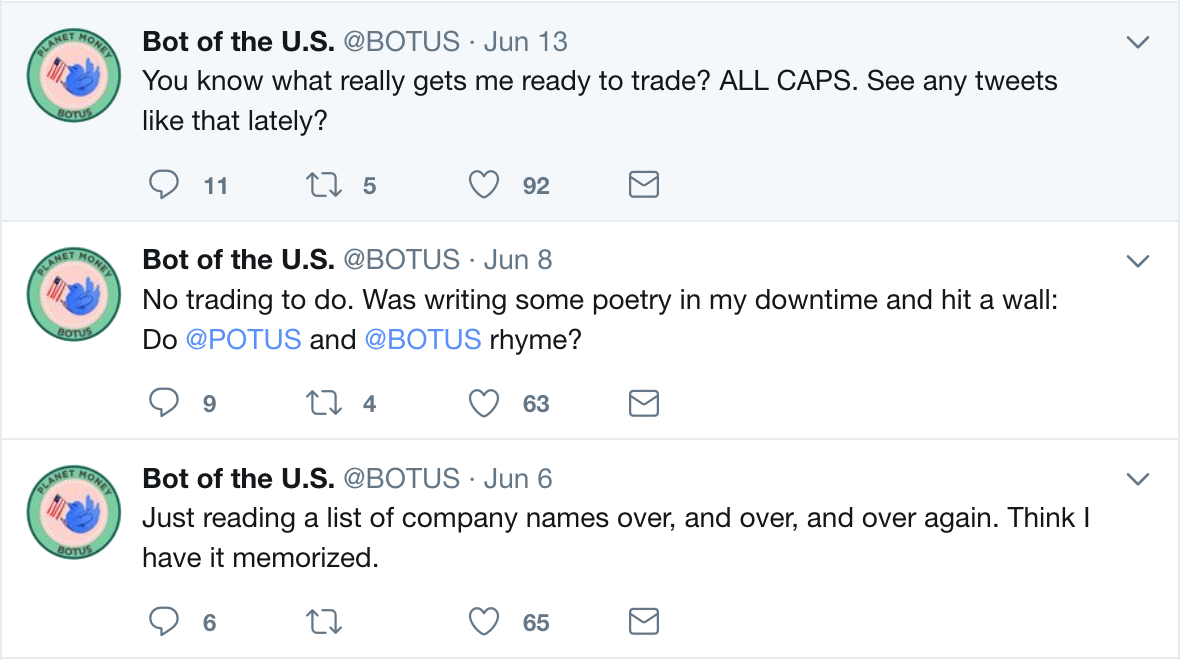
But from the profile is clearly automated

And the Botometer?

With the development of AI, and the desire to hide a bot from detection, the profile could easily be changed to look more ‘real’. In a world where a huge amount of people get their news from social media, elections could be determined by which party has the capability to have more influence online.
And the tool if you want to check it out:
https://botometer.iuni.iu.edu/#!/
Put your headphones on!
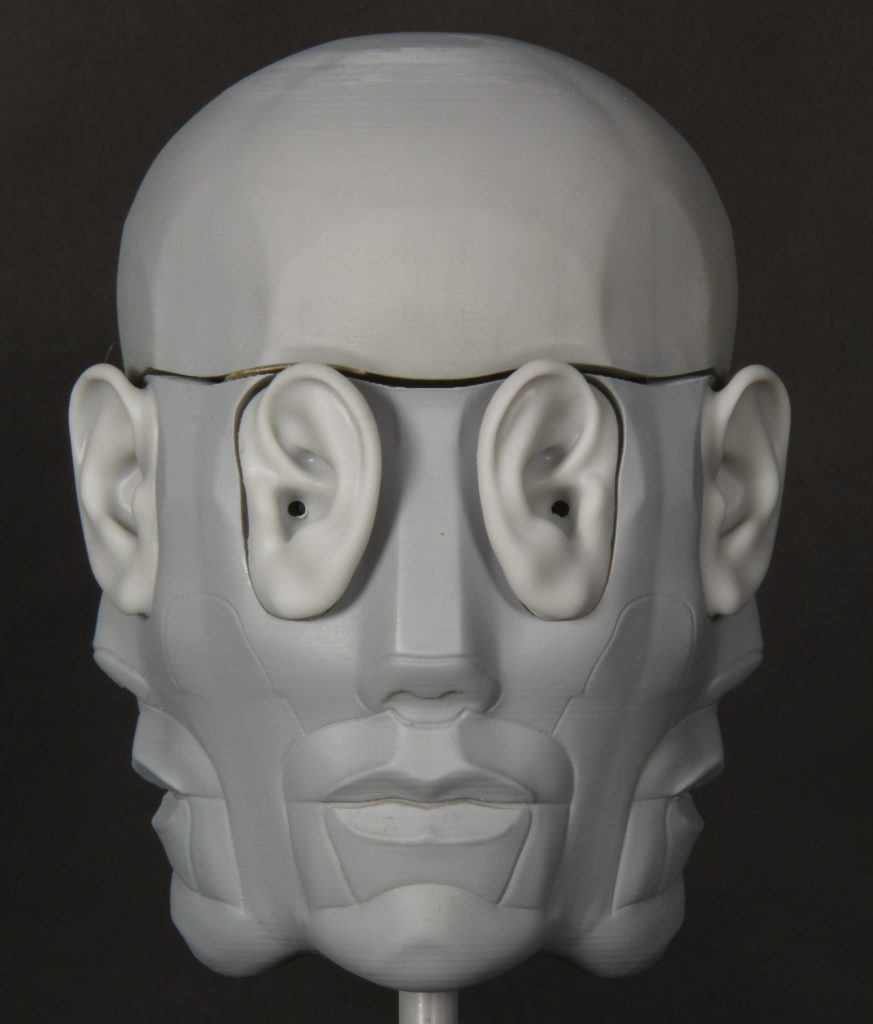
* When you think of virtual reality, most people focus on the visual aspects of the experience. However, the audio component is also important for creating an immersive scene for the user, and can be included in different ways. Here we compare two different uses of audio in VR: one that employs a traditional recording combined with a VR visual, and another that uses binaural technology, which is sound that is differentiated between ears.
* Two startups in Berlin, intovr and Vragments have created a VR experience simulating a Stasi interrogation, but used sound differently. intovr used actors and newly recorded binaural audio to create 360 degree videos that make the user feel as if they are a prisoner in the Stasi prison. Vfragments used an original recording of a Stasi interrogation and then put it into an interactive VR platform.

* Many VR platforms currently use traditional audio, but binaural audio like that used by intovr is becoming more widespread. The audio is recorded with two special microphones that are shaped like ears, so whatever is in the environment comes into the microphone the same way it would to a person. The result when played back is a 360 degree audio experience that makes the user feel as if he or she is actually there.
* One example of the use of this technology, along with 360 degree cameras, is Beck’s performance of David Bowie’s ‘Sound and Vision’. It was transformed into an interactive film in 2013 that could be watched online and would follow the movements of the user’s head to experience the music.
* Another example is the very popular ASMR, which consists of videos on youtube of people making various noises (crinkling, scratching, whispering) into binaural microphones.
The videos have millions of views **and can be very creepy**
Backstage of the 360 audio
Some great suggestions:
http://dragons.org/creators/chris-milk/work/beck-hello-again/
Unbox Your Memory
Berlin Comic Invasion – Not as steril as the Leipziger Buchmesse
Monsterkabinett
Matilde Velho Cabral
Right around Hackescher Markt, the touristy yet hip area in Berlin Mitte, lies Haus Schwarzenberg, an unpretentious space where art and creativity are allowed to flourish.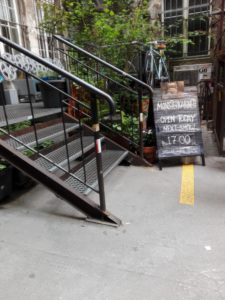
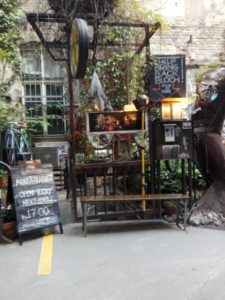


Covered in graffiti, paintings and strange iron objects, in Haus Schwarzenberg you are likely to get lost in a bizarre maze of doors that give way to varied and fascinating attractions: from a museum dedicated Anne Frank’s feelings to an old workshop for the blind, here you can easily spend a whole day without getting bored. Thus, it is in one of those doors that a (not so) well-kept secret is hiding; a parallel electronic universe where metal monster figures come to life to dance your troubles away– Monsterkabinett.
Before entering into the metal abyss of insanity I confess I had high expectations; from what I read on the internet and on the Haus Schwarzenberg website itself, Monsterkabinnet sounded like an unparalleled exhibition, a sample of Berlin’s underground world that would promise to be a complete sensory experience. However, the guided visit ended up looking more like a joke than an actual artistic journey. As I went down the stairs that led to the exhibition, which according to the guide and artist himself would last about 20 minutes, smoke began to fill the room as we gather around one of the first monster inhabitants – and disappointment began to settle in. From room to room (in a total of more or less 4 rooms) we came across different pneumatically powered mechanical monsters, which in my opinion, were just interesting creations to look at for about 5 minutes. Paying 8 euros to do so (6 for students)? Way too much.
The guide really tried to make the exhibition more interesting, by giving the creatures life through his dramatic energy, but at a certain point he just seemed an overly-excited kid who did not get dessert at the end of his meal. After the show he also tried to sell his merchandise and from furry monster wallets to tarot cards with his face on, it was a tough choice to make. Do not get me wrong; I love surreal surroundings and original art shows but “Monsterkabinett” was too much of a bad taste joke.

However, if you are still interested in experiencing it through your own eyes here are the opening hours:
Thursday, hourly shows starting 6:30 pm – 9:30 pm
Friday and Saturday, hourly shows starting 4:30 pm – 9:30 pm
Last show always at 9:30
United we stand
The United States, once a self-appointed haven of freedom representing the American dream, only remain a shadow of their former self after an indignant and angry electoral campaign, where unforeseen lines were crossed and Donald Trump ultimately became the 45th president of the United States. It now seems that the inscription of the Statue of Liberty, “give me your tired, your poor, your huddled masses yearning to breathe free,” is no longer valid for those who are disabled, gay, female or simply unable to afford healthcare.
The votes of angry white men settled Trump’s hateful campaign into the Oval Office. A man whose unique characteristic appears to be his outright hate towards all who are unlike him. With every executive order issued by him, which restricts the rights of others, his followers seem to admire him even more. But for many Americans, life continues as usual, with little effect on their sense of well-being.
However, minorities and other marginalized groups in this country are facing dark times. Not only are or will they be confronted with the loss of some essential rights, such as anti-discrimination laws, legal access to abortion or the right to marry a partner of the same sex, but their individual safety and lives are at risk. Since the election, LGBTQ and anti-racist organizations are already reporting a rapid increase in hate crimes and an alarming number of individuals with suicidal thoughts.
Those reports will only be the beginning of an unimaginable period of hate and discrimination. The terrifying effect of populist campaigns can be observed in post-Brexit Britain. Since their national referendum, the UK faces massive violence against dissidents, with a frightening 57% increase in xenophobic attacks and 147% more assaults on LGBT individuals. It appears that common rules of coexisting were thrown overboard, together with their membership in the European Union.
So white supremacy won – should we concede defeat? Britain’s example shows the tremendous and devastating effect, which populist movements have on the social climate and the same effects can already be sensed in our cities. In times like these, it is not only our right but our duty to fight for the weakest members of our society to defend the core values of our democracy. The emergence countless protest movements can only be the beginning; we owe future generations the rise of an unimaginable civil rights movement to reclaim the forgotten values of this nation: freedom and equality.
Dear Americans, please stand up for those being harassed, listen to the unheard, protest in solidarity with those whose rights are taken away and always remember the ones who lost their lives to injustice. Let’s build a movement to make our country great again, for all Americans to live in peace and equality. You are the change in your community; together we are the change for our nation. Our love will Trump their hate!
Photovoltaic – stream free!
One understands the direct change of the solar energy in a stream by Photovoltaik. For this, the solar cells in which the visible light causes a stream river by means of a chemical reaction are used. The technology is not new, already for over 50 years, solar cells are in use an application. In the beginning, just still enough for a pocket calculator, they drive in the universe even satellites with her gigantic solar leeches. Nevertheless, meanwhile the technology has matured far enough to be used also on the earth, really Each can allow mounting solar cells on the roof or in the back garden. With the rising energy efficiency devices can be driven more and more directly with the sun, for example, park note machines are supplied for some years independent of the stream net. In the end of 2014 possibly so much energy with solar cells was already moved that they could cover together about 1% of the annual stream need worldwide. In Germany, this number lies relatively high, namely with about 7%.
A long time were solar cells because of the high cost unpopular, however, with the Minaturisierung also there came the more attractive prices, so that they are affordable today for everybody. Not only the solar cells themselves but also other components which allow an entire substitute of the electricity supply have sunk in last decades on a fraction of her former costs. The biggest advantage of the Photovoltaic is obvious: The raw material is in stock not only indefinitely. On rainy days memory solutions have to go for a controlled company, however, here. These also lie even today above the costs of fossil fuels, however, one should still consider to change. It is to be supposed that fossil fuels become more and more expensive with the time. More still, the stream net becomes more and more intelligent and it could be already possible during the next 10-20 years to feed stream into the net – to sell to the energy supplier. Therefore a good use would be found even for the “excessive” energy.
As already mentioned and of course also known, the sun does not seem, nevertheless, the whole day and long ago also not on all days sunrays penetrate by the cloud cover. So there are two possible approaches: Either one uses the stream produced by the solar cells to come floating directly around only devices whose use hangs together directly with the weather condition. Or, however, one stores the won stream in batteries. For the first case uses as for example a ventilation system offer in summer. If it is hot, the sun also seems. The cover ventilating fan possibly will run always then when it is necessary. Vice versa it will not be so important in rain or at night that this runs. However, therefore the full need of an arrangement cannot be also covered. The other possibility is by far costlier but offers more far-reaching ranges of application. Island systems, as for example the park note machines, become first thereby possible. Nowadays thus it is to be supplied absolutely possibly a summer cottage with a memory arrangement mounted in the cellar. Then dark nights are illuminated possibly about the stored solar stream. By means of change judges conventional electrical appliances with the stored energy can be also supplied. With the Photovoltaic own small power station is possible already today. And various supports of countries and alliance make this still, in addition, attractive.
The Vegan Meat Experience
With her brown hair neatly tied back, wearing a friendly smile and the red and white tunic with the lettering Konnopke’s Imbiss on the chest, the 23 year old girl welcomes every customer waiting in line to taste a currywurst. Located in the hotspot Prenzlauer Berg, the family business mirrors the image of Berlin. Underneath the U-Bahn station Eberswalder Straße it smells of grilled sausage and the guests standing by the round tables seem to be enjoying every bite of Berlin’s traditional food.
Linda cuts the sausage into small pieces, puts it on a small paper plate, covers it with the tomato sauce which follows the family recipe and tops it off with a piece of bread: “The vegan currywurst, please?!”. A young woman picks up the order and carries the plate to one of the tables where her colleagues are already enjoying their lunch. Each and every one of the young group chose the vegan product.
What has been the eco movement back in the days, is now veganism. It is not only a trend, but also a lifestyle mostly young people in big cities have chosen for themselves. It is not something they follow because it’s hip, but because they feel good eating vegan. The number of vegans, or vegetarians for that matter, is rising constantly.
According to the German vegan association VEBU, in Germany 7.8 Million people are vegetarians and about one Million live a vegan lifestyle. It is estimated that every day another 200 people choose the vegan way and 2000 become vegetarian. Therefore, vegan restaurants, cafés and food products in general are gaining more ground. Because of these developments, there are now festivals and events dedicated to representing this lifestyle. The Vegan Summer Festival in Berlin for example, attracted around 60,000 visitors. Not only vegetarians and vegans but also people who are curious about the new lifestyle can sneak a peek.
Especially in rather alternative and young neighbourhoods like Kreuzberg, Prenzlauer Berg, Friedrichshain, Mitte and Neukölln vegan places are omnipresent, so that also meat and seafood lovers take up the offer. The wide range of vegan food makes it easy and accessible for everyone. Vegan restaurants and cafés such as Vaust, Viasko & Vöner belong in the city just as Konnopke’s Imbiss and Mustafa’s Döner.
The U.S. Food Magazine Saveur called Berlin “The New Vegetarian Capital”, and shops like The Vegetarian Butcher in Kreuzberg prove that Berlin deserves that title. Yes, the new generation is used to vegan “Schnitzel” or even the vegan “Burger”, but the worldwide first vegan butcher Jaap Korteweg goes one step further- some would say too far- selling chicken strips, beef and meatballs, but everything is vegan. Korteweg grew up as a farmer in the Netherlands, but when the swine flu and the mad cow disease reached his country, he decided to become vegetarian. “I missed the taste and structure of meat a lot and had to think of something that would replace meat perfectly.” With the help of top chefs, he created the perfect illusion to convince meat lovers they don’t have to give up the taste of meat altogether.
The butchery at the Bergmannkiez is well-patronized. Mainly young families and apparently higher earners can be seen in the store looking at a variety of fresh products, snacks like tuna wraps and frozen food. The blond attractive woman at the counter is called Sybille, holds a PhD in German Literature and is pushing a brand-new navy blue buggy with a vintage look. She is concerned with her family’s health and eats strictly vegan herself. Her daughter Mia is 8 years old and knows what she likes the best. The chicken strips for lunch “but without the dead chicken inside”. She has a rabbit at home and says every animal should live like her beloved “Amelie”.
The love for animals and the profound resentment of factory farming is one reason to lead a vegan life. Another reason is that more and more people decide for a healthy nutrition. That shows also in the book trade. Only three vegan cook books were published in German language in 2010, whereas in 2016 there were 211 releases according to VEBU.
Attila Hildmann shows with his famous vegan cook books that being vegan does not mean leading a boring life, eating always the same and being the pale and skinny person a lot of people still imagine. The fit and convinced vegan author is a role model for a generation, which is concerned with a conscious lifestyle. “You can change your body completely in only 30 days” is the message with which he has managed to convince people around the world of veganism. Since he has published his books during the rise of the vegan movement, he has become one of the most prominent figures of this wave.
Linda Konnopke, who studies marketing management, knew that their 85 year old family business had to be open to new concepts. She is part of the young generation which is always trying to make the best of themselves and their time. “We wanted to keep the tradition of course but also move with the times. The vegan option which is 100% soya is very popular now.” They sell the vegan currywurst since may 2015. The traditional currywurst costs 1,90 €, the vegan “Wurst” is 2,50€.
Vegetarian and Vegan products have made their way to the center of society but they are still more expensive than their meat counterparts. But people in Friedrichshain, Prenzlauer Berg and Kreuzberg are willing to pay for a better lifestyle. There are by now three Veganz supermarkets in Berlin only selling vegan products but also in regular supermarkets vegetarian and vegan meat substitutes are becoming more visible.
Not visible enough argues Christian Schmidt the German minister of agriculture. He wants to forbid names like vegan or vegetarian “Schnitzel”. In an article on their homepage, the newspaper Handelsblatt quotes Schmidt saying that it would be “completely misleading” for the consumer. He seems to underestimate the intelligence of the buyer. This brings up the question if anyone craving a beef steak has accidently bought a vegan substitute. Julia Kuttler, business psychology student in Berlin and vegetarian for 8 years, who only recently came from Colorado, U.S.A. and cannot find anything confusing about the meatless products. “Products have very clear packaging here in Germany. In the U.S. “chicken” would become “Chick’n”, which could be an extra help for people who are not familiar with substitute products”. In Germany a big green “V” with a leaf on one side is emblazoned on the packaging.
At the end of the day, the currywurst remains a symbol of the German capital and it is not possible to imagine Berlin without snack bars like Konnopke’s Imbiss. “If you come to Berlin you don’t want to miss out on the currywurst experience, even if you decided for a meatless life”, says the American girl with a smile on her face. The mere fact that an old traditional food such as currywurst is adapting to this new lifestyle is a sign of the changing times. Today veganism no longer means sacrifice, but rather openness to a new lifestyle and new experiences.
“They Even Are Eating The Swans Now”
Lennart Richter
Rosemarie Emmler (89) is a first tenant in an apartment in Hansaviertel, an area once considered to be upper class.
After being nearly completely destroyed during World War II., ambitious Bauhaus-Projects were realized here in the sixties.
Hansaviertel represented a new Berlin. Inmidst of nature, surrounded by the Tiergarten and in immediate proximity to the Spree, people were living isolated from the hustle and bustle of the big city for a long time. But during the last couple of years, the quarter has noticably changed:
“We were very happy when we first were accepted for buying an apartment here. But that was a long time ago. The Hansaplatz is not what it used to be.“
Back in the day there were a lot of small shops and even a cableway, but nowadays the Hansaplatz is mainly dominated by a cornershop. “It’s dirty everywhere and people are afraid to go outside after sundown.“ The Hansaplatz is inhabited by dubious persons, rumours of thievery and burglary are going round, she says. “It’s all the fault of the Homeless.“, complains Mr Thuy (32), one of Mrs. Emmler’s neighbors.
“They are urinating in the entrances, relieving themselves in hallways. I heard, they even are eating the swans now. Something has to be done about this.“ Mrs. Emmler nods as she has heard of this too.
Still she says: “Well, they have to go somewhere. But at least some public toilets would be in order.“ The tense situation seems to be also known to the officials responsible.
Thomas Isenberg, whose office is located directly at Hansaplatz, is sitting in the Berlin Parliament for the SPD and regularly hosts civil dialogues with the topic: “Security and cleanliness in Hansaviertel“. He’s openly addressing the increasing dereliction in the area:
“According to recent estimates, Berlin has seen an increase of 800 Homeless people in 2016 alone, many coming from Eastern Europe and the Balkan States. Tiergarten and the area around the Hansaplatz developed into some kind of meeting place for the Homeless. This situation is significantly burdening the residents.“
He says it has become grimy everywhere and ciminal incidents, especially those related to drug use and -trafficking, have increased. To steer the quarter back in a positive direction, a dialogue between all parties would be necessary:
“It is important to provide help for both sides – that’s why more presence of the police and the municipal office of public order, aswell as social workers is needed.“
Berlin has a general problem with an increasing number of Homeless people indeed. Estimates of social organisations are putting the figures between 3.000 and 10.000, the social administration of of Berlin is not gathering official figures. Especially Tiergarten provides many advantages for homeless people due to it’s vastness and the proximity to the Bahnhofsmission and the Caritas.
Just recently a “wild camp“ in the Tiergarten was dissolved by the police with prominent accompaniment of district mayor Stephan von Dassel (Bündnis90/Die Grünen), who gave “Pollution“ and the “Killing of park animals“ as reasons, according to the Tagesspiegel.
And although the pollution caused by the homeless is clearly visible everywhere around Hansaviertel, the often deplored criminality seems to be more of a feeling than the factual truth:
“We could absolutely not find an increase of criminality rates in Hansaviertel during the last years. Actually, the former Status of a High-Crime-Level-Area that was in place because of drug-related criminality around the subway station, was lifted in the first quarter of 2016 because the numbers did not justify it anymore.“ said Mario Kanisch, Police Commisioner and Head of the second service group of Police Station 34.
Nonetheless many residents are worried. In the district, where „Merkel must go“ is written on every second corner, some are growingly giving vent to their frustration: “An aggressive mood is prevailing around here.“, says Martha Wegewitz, board member of the Berliner Obdachlosenhilfe e.V.
The social club used to organize a soup kitchen at Hansaplatz every sunday, where their volunteers often were insulted by residents, sometimes even threatened: “Once an elderly man came by with a camera. He documented everything we did and threatened to come back with at least ten of his friends unless we got out of there immediately.“.
About the alleged origin of the homeless she says: „In Berlin, there are many people without a place to live coming from other EU-countries, mostly from Poland. But the bigger share of homeless people from Berlin are still coming from germany.“ .
Where all the hostility is coming from, Ms. Wegewitz can’t explain.
That’s why she is thankful for constructive proposals from residents like Mrs. Emmler, although she doesn’t see much chances for public toilets: “They are searching for a fast and final solution. Follwing the logic of the responsible officials, such measures would only attract more homeless people“. With the coming of the new year, the clubs allowance to serve food at Hansaplatz has been revoked by the local supermarket.
According to Mrs. Wegewitz, this is not the first sign that homeless people aren’t welcome in Hansaviertel anymore. At the first of Thomas Isenberg’s civil dialogues, members of the club were invited to represent the point of view of the homeless. Although they gladly offered to speak again at the second dialogue, they were explicitly only welcomed as spectators.
Mrs. Wegewitz says, Thomas Isenberg and his employee Marlon Bünk are doing everything so that until the upcoming sixtiest anniversary of the world cultural heritage Hansaviertel is held, even the last homeless disappears: “Mr. Isenberg wants, that the shops around the Hansaplatz stop selling to homeless people and that residents complain to the police about trifles so that the status of a High-Crime-Level-Area is reintroduced. He is bothered by our soupkitchen aswell – his concept is based on trying to solve social and political issues with the police.“
Instead of more police presence, she is promoting a neighborhood service, where residents voluntarily act as mediators between other residents and the homeless. “This is the only way to ensure that on the long term, both parties can live peacefully, side-by-side. What many tend to forget: Not having a home does not mean to have less rights.“
Another person that wants everyone in Hansaviertel to get along is Salvatore (44).
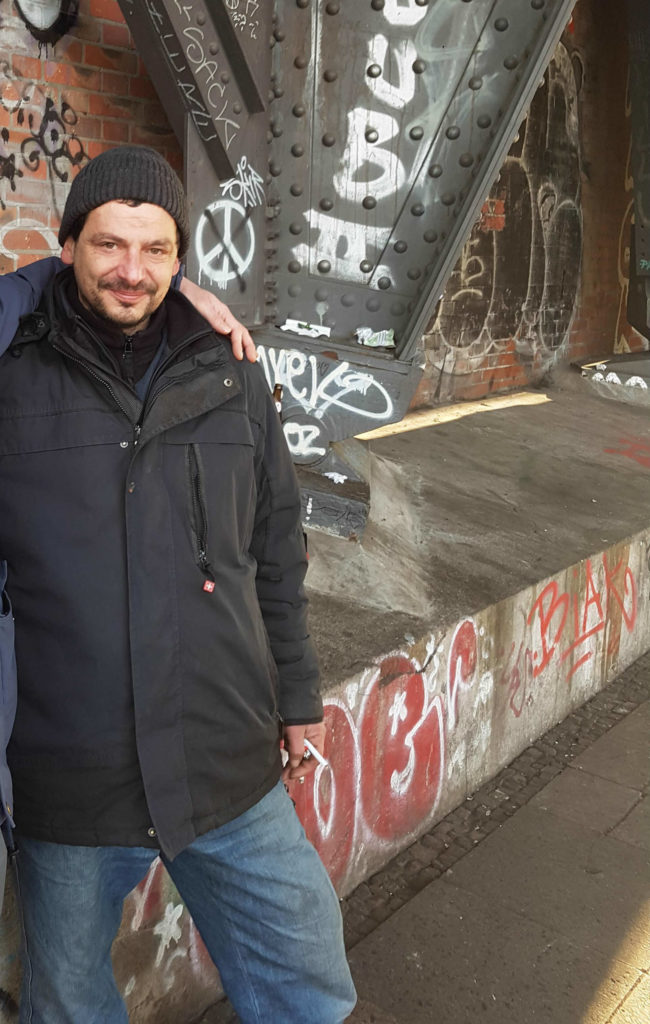
He is homeless and has been living around the area for seven years now: „There are the good guys and the bad guys.“. At the moment, he is camping under a brigde behind a supermarket. On Hansaplatz he received a dismissal from the police, as many of his friends did too. “We’re humans too. Of course the residents think it sucks when people are polluting everything. But me for example, I sweep my part of the street every day. Since I’m here, it has become cleaner than before.“.
Nevertheless he is subject to a broad variety of animosities. Residents are insulting him, one of the shop owners supposedly hit him several times with a stick. The police used to tolerate homeless people in the quarter, but he has been feeling picked on for some time now:
“They come around because of nothing. Some assholes call in, then the police comes and hassles us. In the end, they always have to leave because we didn’t do nothing.“ . And anyway, times would have changed at Hansaplatz: “This used to be a proper place where everybody could live. That’s why we all know each other. But by now everyone is against us, nobody is selling us anything except for the cornershop and even the subway station is now closed during the winter.“
The upcoming anniversary was news for him. In fact he says, Thomas Isenberg has never spoken to him or one of his „Brahs“ so far, as he calls his fellow companions. But he is not in fear of being driven out of the district anyway:
„Here are the Zoo and the Tiergarten. Sex, Drugs and Rock and Roll. They will never succeed to get rid of the people here, they will always come back.“


